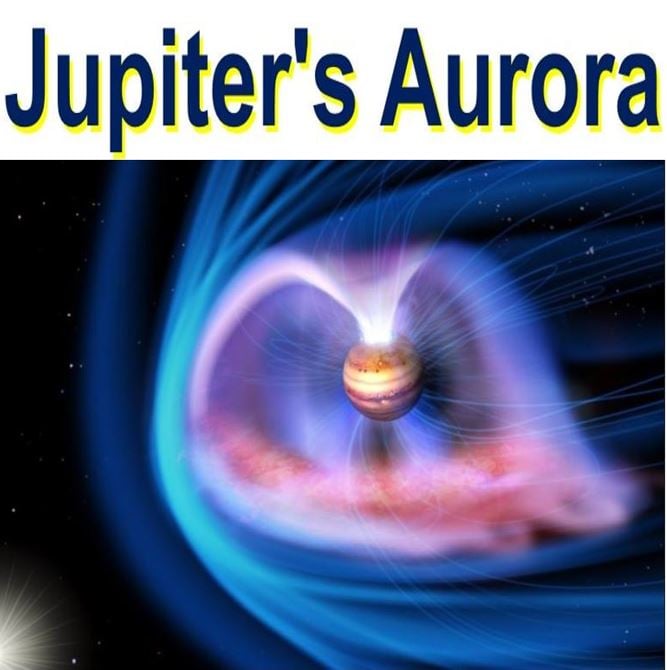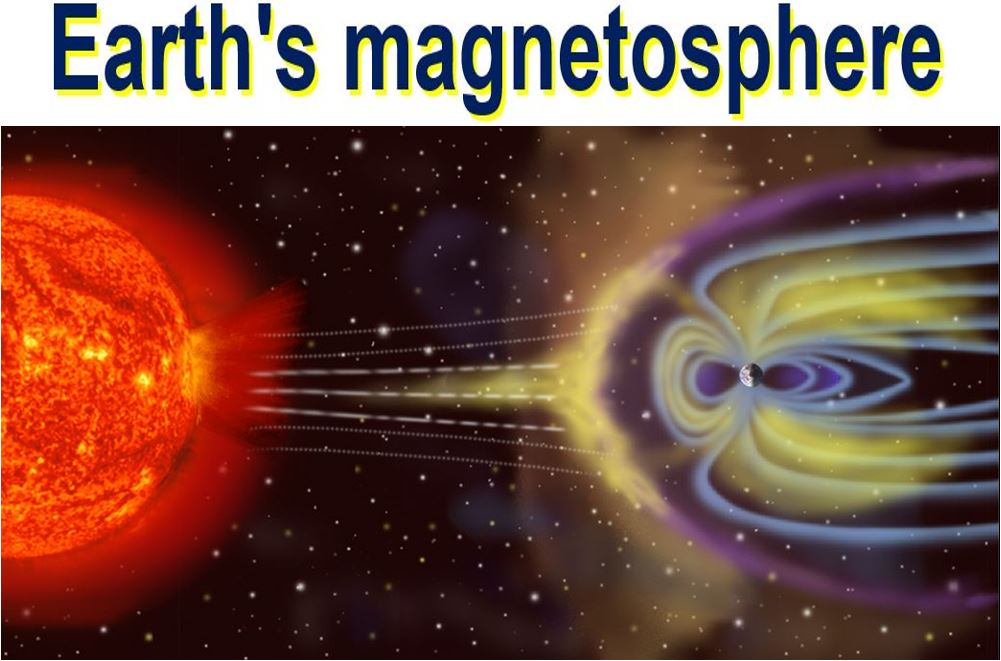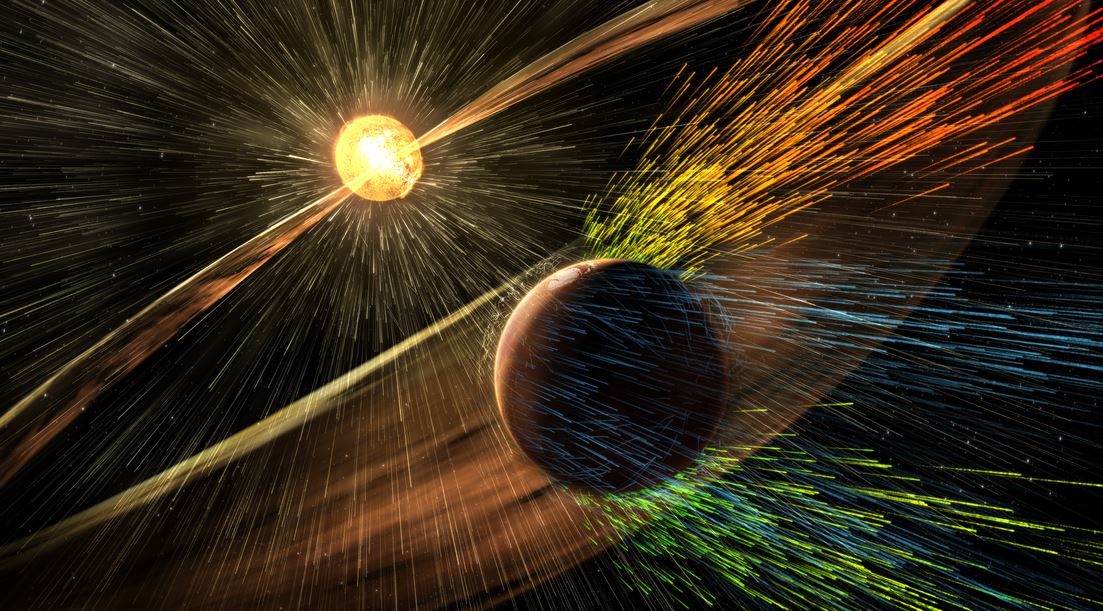Spectacular auroras are being observed around Jupiter, caused by the solar wind around our Solar System’s largest planet, which is causing intense X-ray bursts over its polar regions, says a scientist from Imperial College London and colleagues at JAXA (Japan Aerospace Exploration Agency).
Details on this latest study and its findings have been published in the Journal of Geophysical Research (citation below).
Auroras appear when fast-travelling charged particles hit a planet’s atmosphere. On our planet, we see this as the Northern Lights Aurora Borealis and Southern Lights Aurora Australis over the Polar Regions.
 An artist’s impression of Jupiter’s X-ray aurora and the magnetosphere. (Image: imperial.ac.uk. Credit: JAXA)
An artist’s impression of Jupiter’s X-ray aurora and the magnetosphere. (Image: imperial.ac.uk. Credit: JAXA)
Auroras exist in visible and invisible parts of spectrum
Other planets in our Solar System, including Jupiter, also have auroras over their polar regions, but these are not just observed in the visible part of the spectrum.
Auroras also exist in the X-ray and UV (ultra-violet) portions of the spectrums, invisible to the human naked eye, but extremely vivid if you use the right instruments.
Scientists were not certain what created Jupiter’s X-ray aurora – aurora’s have several different possible causes. They knew much of it was the result of carbon, oxygen and sulphur (US English: sulfur) ions being accelerated to nearly the speed of light before hitting Jupiter’s atmosphere. However, they wondered what was causing them to speed up.
 (a) Jupiter’s X-ray image measured by CXO/HRC and (b) that measured by XMM-Newton/EPIC-pn during Jupiter’s in April 2014. The spatial scale is the same in Figures 1a and 1b. The green rectangle in Figure 1b is located at the northern auroral region aligned with Jupiter’s equator. The auroral X-ray photons from the green-framed region are extracted for spectral analysis. The green circle in indicates the background region from which photon count rate and spectra of the solar radiation are extracted for the background noise reduction. (Image: onlinelibrary.wiley.com)
(a) Jupiter’s X-ray image measured by CXO/HRC and (b) that measured by XMM-Newton/EPIC-pn during Jupiter’s in April 2014. The spatial scale is the same in Figures 1a and 1b. The green rectangle in Figure 1b is located at the northern auroral region aligned with Jupiter’s equator. The auroral X-ray photons from the green-framed region are extracted for spectral analysis. The green circle in indicates the background region from which photon count rate and spectra of the solar radiation are extracted for the background noise reduction. (Image: onlinelibrary.wiley.com)
Now, using the data from three different satellites that observed Jupiter simultaneously, an Imperial College London scientist together with colleagues from the Japan Aerospace Exploration Agency (JAXA), discovered that the acceleration required for the X-ray aurora is triggered by the solar wind.
The solar wind is a continuous flow of charged particles from the Sun which permeates the solar system. Its intensity fluctuates, and is most intense when the Sun releases coronal mass ejections.
Coronal mass ejections (CMEs) are giant clouds of solar plasma drenched with magnetic field lines that are blown away from the Sun during strong, long-lasting solar flares and filament eruptions.
Solar winds cause Jupiter’s aurora
By comparing the variation in solar wind with the intensity of the X-ray auroras around Jupiter, the scientists concluded that the solar wind causes this aurora.
 An artist’s rendition of the Earth’s magnetosphere. It shields our atmosphere from solar wind, which might be able to carry away the atmosphere. (Image: Wikipedia)
An artist’s rendition of the Earth’s magnetosphere. It shields our atmosphere from solar wind, which might be able to carry away the atmosphere. (Image: Wikipedia)
After carefully analyzing the X-ray emission, they found that they peak in regions near to Jupiter’s magnetic poles. This means they probably come from the outer edges of its *magnetosphere, where interaction with the solar wind occurs.
* The magnetosphere is the region surrounding a planet (including Earth) in which its magnetic field is the predominant effective magnetic field, i.e. a planet’s protective magnetic bubble.
Exploring planets outside the Solar System
Jupiter has the strongest auroral displays in our Solar System. Scientists hope that by gaining a better understanding about their causes, they can determine how effectively celestial objects like Jupiter are protected from the force of the solar wind.
This has wide-ranging implications for the study of planets outside our Solar System (exoplanets), where the degree of this natural magnetic protection is an important factor on a planet’s habitability. Without magnetic protection, life as we know it is not possible, even in planets within the habitable zone.
 Artist’s rendering of a solar storm hitting Mars and stripping ions from the planet’s upper atmosphere. Mars lost its magnetic field some time around 4.2 billion years ago, scientists say, exposing its atmosphere to the solar winds, which blew much of it away into space. (Image: nasa.gov)
Artist’s rendering of a solar storm hitting Mars and stripping ions from the planet’s upper atmosphere. Mars lost its magnetic field some time around 4.2 billion years ago, scientists say, exposing its atmosphere to the solar winds, which blew much of it away into space. (Image: nasa.gov)
Dr. Adam Masters, who works at the Department of Physics at Imperial, who helped the scientists interpret the connection between the solar wind and Jupiter’s magnetosphere, said:
“This study is a great example of multiple satellites being used to tackle one of the biggest questions in planetary science. By understanding how different planets are protected from the solar wind, or not, we can really start to say something about the possibilities for life on planets beyond our solar system.”
“We have only to look at Mars to see the importance of planetary protection from the surrounding space environment, where the decline of Mars’ global magnetic field is likely why so much of its atmosphere has been lost.”
Finding the cause of auroras
While Earth’s visible aurora is triggered by the solar wind, that is not the case for all auroras.
Jupiter’s spectacular blue aurora is triggered by eruptions of charged ions from Io – one of its moons – which is pulled and squashed by Jupiter’s gravity and that of its other large moons.
Jupiter’s aurora in the ultraviolet part of the spectrum is caused by the rapid spin of the planet itself.
To determine which of these possible factors was the culprit in forming Jupiter’s X-ray aurora, three satellites observed Jupiter for a period of two weeks in April 2014.
Jupiter’s UV aurora was measured by JAXA’s HISAKI satellite, while the strength of the X-ray aurora was monitored by NASA’s Chandra X-ray observatory. ESA’s XMM-Newton satellite looked at the chemistry of the aurora’s ions, determining that they largely form the solar wind itself, instead of being flung out by Io.
Citation: Kimura, T., et al. (2016), “Jupiter’s X-ray and EUV auroras monitored by Chandra, XMM-Newton, and Hisaki satellite“, J. Geophys. Res. Space Physics, 121, doi: 10.1002/2015JA021893.
